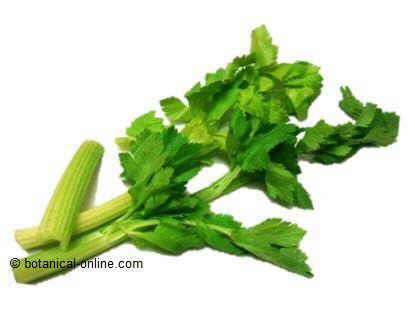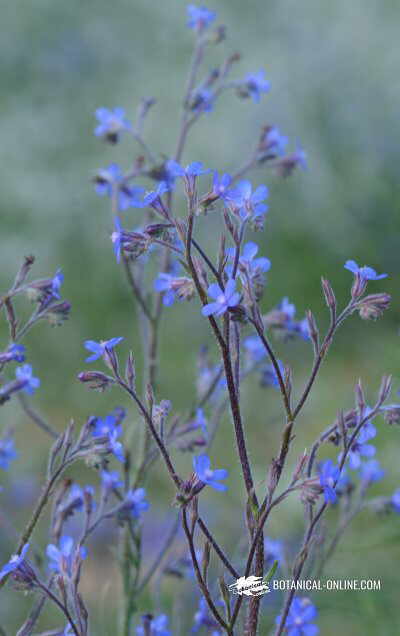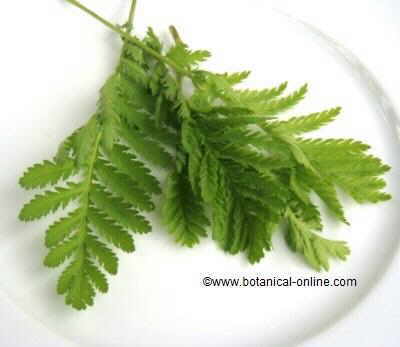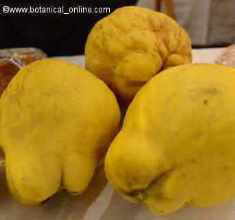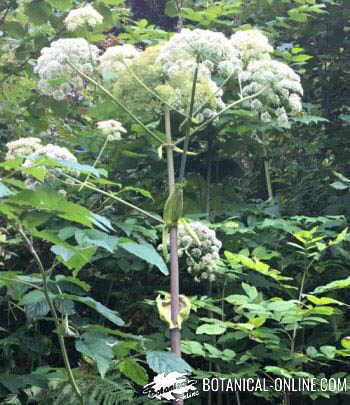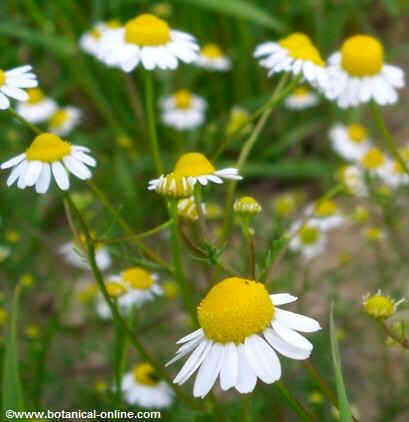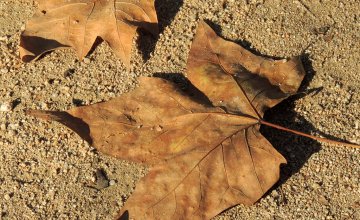Contents
- 1 How to grow aloe (Aloe vera)
- 1.1 Aloe vera care
- 1.2 Aloe vera characteristics
- 1.3 Aloe vera irrigation
- 1.4 Aloe vera uses
- 1.5 Aloe vera environment and exposure
- 1.6 Aloe vera propagation
- 1.7 How to propagate aloe vera from suckers?
- 1.8 How to propagate aloe vera from rhizomes?
- 1.9 Can aloe vera be reproduced by seeds?
- 1.10 Aloe vera, soil types and maintenance
- 1.11 Aloe vera leaves collection
- 1.12 Aloe vera pests and diseases
How to grow aloe (Aloe vera)
Aloe vera care
![]()
Aloe vera characteristics
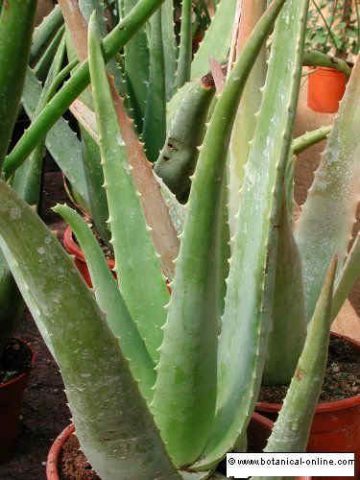
Perennial plant of the Lily family – Liliaceae – up to 60 cm.. Succulent leaves in basal rosette, lanceolate, with the margin covered with thorns, glaucous and with reddish tones.
Yellow, bell- shaped, hanging flowers, till 2,5 cm in terminal spikes on woody cylindrical stems, without leaves.
Native form India, it can be found naturalized in the north of Africa and more rarely in the south of Europe.
It is grown mainly in the United States, Japan, Mexico and the Caribbean.

Aloe vera irrigation
Aloe vera needs very little water. Over watering leads to leaves rotting, starting from the bottom.
Like other succulents, it is better going a bit on the dry side. Especially, when planted in pots, we must ensure that the bottom drain hole can drain it well
Planted outside and under normal precipitation conditions, watering will not be necessary in most cases, except in summer with no rain. In this case, watering once every month will be enough.
During the rest of the year, we will apply very little watering, either if it is planted on the ground or in pot. Only when we see that the soil is too dry, we will need to water it. To know when to do it, we will make a test by inserting our finger a little on the ground.
If a little soil is stuck on our finger because there is still some humidity, we will wait for it to be more dry. In practice, we usually water once a week during the summer, once a month during the winter and every 15 days the remaining months.
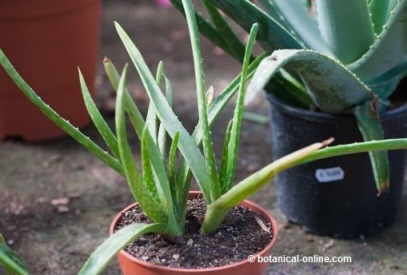
Grown indoors, we must be very careful with the conditions of light and moisture. We will seek a well-lit place by a window, without being placed in full sun. The lack of light tends to produce narrow leaves and a too much elongated upright growth.
Indoor humidity is always lower than in the outside, which is not a problem for most of the year except in winter when heating that can dry out the soil excessively. When conditions of lack of moisture appear, aloe vera typically has an abnormal growth that manifests itself as wrinkled, spindly and narrow leaves, with their edges bending inward. This is because the plant is spending its own liquid for water.
![]()
Aloe vera uses
Aloe vera can be used in rocky, sun-exposed slopes gardens or it can be potted. In some places, it is extensively cultivated for medicinal use or for extracting aloe gel widely used in the cosmetics industry. (See Properties of aloe vera in the listing below)
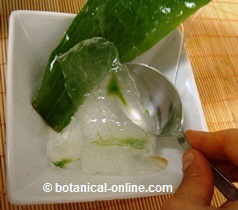
![]()
Aloe vera environment and exposure
Aloe vera should be grown in a brightly lit place, better in a sun-filtered one that in direct sunlight. When plants are subjected to direct sunlight, they tend to darken .
It is a warm weather plant that can not stand frost, so outdoor plants should be protected in winter. The ideal growing temperature is between 19 and 25 ° C.
In cold winters climates, it is best to plant them in pots or containers that can be transported inside. Temperatures below 7 ° C may cause them damage if wet, but completely dry on the floor, it can withstand much lower temperatures, hence irrigation should be restricted in winter when the plant should be exposed to cold climates.
Aloe vera prefers dry environments. Conditions of high humidity cause damage to its leaves or rot all the plant. So, when watering, it is important for the the leaves not to get them wet. When potted, a watering can may be used to allow water access to the soil directly without wetting the leaves.. Good ventilation is necessary to produce healthy leaves.
It is a plant virtually impossible to grow outside in cold and damp places. In this case, it should be planted in pots or containers that can be transported inside when conditions are not suitable. Although aloe vera grows faster outside, when properly cultivated indoors, it can produce magnificent specimens.
![]()
Aloe vera propagation
The easiest way to propagate it is by means of suckers (shoot springing from the base) or rhizomes (underground stems) in early spring.
How to propagate aloe vera from suckers?
In the first case, the first thing we will do is to separate the sucker from the rest of the plant with a disinfected sharp tool. To do so, we will cut through the point where the offspring is attached to the rest of the plant.
Once cut, we will give each sucker time to let the wounds heal. Subsequently, we will plant a sapling in each pot, using a mixture of 50 % peat and sand and covering the rest of the surface of the container not occupied by the new plant with a very thin layer of gravel. We will place the pot in partial shade and water it after 3 or 4 days.
Transplantation is performed when the new plant has developed new shapely leaves. We’ll wait until the sprouts have reached a foot high at least. In this case, we will add a standard soil and we will cover the empty superior space with a gravel cover.
How to propagate aloe vera from rhizomes?
When rhizomes are used to propagate aloe, first, we must separate a piece of rhizome from the rest of the plant. So, we will take out the plant from the pot or, if planted in the ground, we will dig on the ground to get access to the rhizome. With a sharp and disinfected knife, we will cut off the rhizome into pieces removing all damaged or excessive roots.
Once separated, we will treat them with fungicide and let them stand a couple of days to heal wounds. Subsequently, we can re-pot them in pots or directly on the ground.
If we prefer to plant them in containers, we will place a rhizome into each container with standard soil and we will cover the spare space on top of the container with a thin layer of gravel. Then, we will place it in partial shade to allow a good rooting, waiting for about 15 days to water.
If we prefer to plant them directly in the ground, we must dig a shallow and wide enough hole. A foot and a half deep by 50 cm wide. Aloe vera rhizome can grow properly. (This type of rhizomatous plants have a shallow underground horizontal growth) Then, we will place it in the bottom of the hole a bed of stones, coarse gravel, bricks or other drainage material to allow good drainage and we will finally cover with standard ground.
Once planted and secured, we will water lightly and, then, we will wait a couple of weeks to water it again. Thus, the roots will become properly rooted having to be lengthened to find moisture on the ground.
At first, the new transplanted plants may become brown or gray, but this does not mean that the process has failed. Over time, they will become green again.
Can aloe vera be reproduced by seeds?
Although aloe vera can be reproduced by seeds, when doing in this way, growth is very slow, so it is preferable to use one of the two methods described above.
![]()
Aloe vera, soil types and maintenance
Aloe vera prefers slightly acidic soils of sandy nature with a good drainage. A mixed soil that is added with perlite or coarse sand with some mature compost can be very suitable. Soil for cacti or succulents can also be used.
Aloe vera has very little maintenance. When potted, according to plant growth, we must transplant it to another bigger pot until it reaches maturity. Once grown completely, which will occur after 3 or 4 years, it is sufficient to fertilize it once a year.
In plantations established on the ground, it is sufficient to keep the area free of weeds and add some liquid fertilizer from time to time until the plant becomes adult.
This plant should be fertilized with caution, because over-fertilization may produce growth delay.
Aloe vera is a plant that produces suckers easily. Excess shoots can have negative consequences, especially when we grow it in pots or containers. Too many suckers can suppose an increase in plant mass that may lead to an excessive nutrients demand that can slow plant growth if needed nutrients are not adequately provided.
Another way to realize that the sprouts are ” sucking ” too much from the mother plant is to realize that leaves have a horizontal growing instead of a vertical one. It is therefore important to remove suckers every year when they reach 7 to 10 cm height.
![]()
Aloe vera leaves collection
Aloe vera is used for its leaves. They can be cut and used for medicinal or cosmetic purposes. However we must consider a number of conditions:
- Only adult plants (over 3 years) contain components in proper proportion to make them effective.
- Plants must be grown properly. Plants which has been subject to extremely cold weather, those which have not been given the proper nutrients, etc. may be less effective than those that have been properly cultivated.
- Leaves should be cut from below at the point where they meet with the rosette of the plant. (The plant does not suffer with this court as it quickly secretes a latex that heals the wound . Best leaves are those that grow down and out of the rosette, as they are older, containing more principles.
- Once a piece of aloe vera leaf has been cut, it is best to use it at the time. However, if you prefer not to use, it can be stored for a while in the fridge. To do this, remove the lateral spines and wrap them with foil.
Aloe vera pests and diseases
Although it is very resistant to pests and plant diseases, aloe vera can be attacked by mealybugs and aphids. The main enemies are ants, which carry the aphids to grow it into the cracks of the rosette. Once there, aphids suck the liquid from the leaves through their specialized mouths and damage the plant.
![]() More information about aloe vera.
More information about aloe vera.

